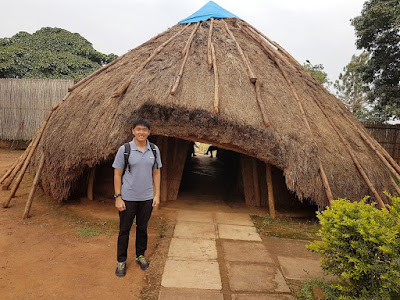Near Doha Port, Doha, Qatar
Sat-Thu: 9.00am - 7.00pm
Fri: 1.30pm - 7.00pm
Let's continue exploring the magnificient Museum of Islamic Art, which is the first of its kind to feature centuries over centuries of in the Arab states of the Persian Gulf. In
Part 1, I wrote about the temporary exhibition on Syria. Part 2 shall focus on the permanent exhibition.

I couldn't take my eyes off the beautiful ceiling before walking up to the second floor.
The museum is said to be one of the world's most complete collections of Islamic artifacts, with items mostly originating from the Middle East, Central Asia, India, Egypt and Turkey.
 |
| Vegetal patterns have been adopted since the early stage of Islamic art. |
 |
| Such an exquisite little box topped with emerald~ |
 |
| Those are jug filters. |
There's a small section on 'Science in Art'.
 |
| The museum has got a lot of astrolabes of different sizes and designs. |
 |
| I was somewhat captivated by the anatomical illustration on the right. |
I wonder how many artifacts does the museum have as the number isn't mentioned at all in the website.
 |
| Don't you love those glass bottle and document holder from Iran? |
 |
| Interestingly, there's a bright blue bowl from Beijing, China. |
 |
| Emperor Shah Jahan of India was the person who ordered the construction of Taj Mahal. |
 |
| That's one of the ka'ba keys found in Mecca. |
 |
| What a fine dagger and scabbard from India! |
Frankly speaking, I'd love to learn Arabic.
 |
| Kufic is the oldest calligraphic form of the various Arabic scripts. |
 |
| I wonder if anyone can actually read the words sewn on that piece of cloth? |
 |
| Have you seen some printing blocks from northwestern parts of Africa before? |
 |
| I love the colours of that ceramic cenotaph. |
There's a small section that displays animal figures.
 |
| Mary had a little lamb~ |
 |
| Time to drink milk! |
 |
| Fancy a jar with harpy and lion motifs? |
Before going up further, let's adore the interior of the museum once again.
The early Islamic period was marked by a unified empire under the Umayyads and Abbasids before the gradual fragmentation as individual dynasties. Despite that, unified aesthetics have been observed across the whole Islamic world.
 |
| Bowls from many different parts of the world are displayed. |
 |
| A pretty mosaic floor! |
The medieval period saw two major incursions by nomadic tribes from Central Asia into the Islamic world: the Seljuks ruled over Iran, Iraq and Syria, while the Mongols created the largest Asian empire ever known to civilisation.
 |
| That's one elaborate candlestick made of bronze with silver inlay. |
 |
| Which one of those caught your eyes first? |
Cairo, Egypt and Damascus, Syria were important centres of art production. The objects shown below are from the 12th to the 15th century.
 |
| I'd love to have one of those ornate hanging incense burners. |
 |
| Those are called sprinklers. Hmm... |
 |
| I wonder if that small, thin bottle served any purpose in the past besides being an object of art. |
Timur, the founder of the Timurid Empire in Persia and Central Asia in 1370, was known for his avid patronage of art.
 |
| Spectacular tilework was one of the hallmarks of Timurid Empire. |
 |
| I hope no one here is maskaphobic. |
I saw a few paintings there.
 |
| Occupational hazard: as a Chemistry teacher, I immediately thought of enantiomers there and then. |
Last but not least, here are the latest collections from the 16th to the 19th century.
 |
| If ever sold, how much do you think would that Persian carpet cost? |
 |
| Expensive jewellery made of emerald and diamond! |
 |
| The one and only Arabic word that I can recognise is Allah (lit. God) on the top right hand corner. |
Here are two final photos of the beautiful interior of the museum.
Before leaving, I noticed a crowd gathering on the first floor. It was then I realised that the museum was celebrating its 10th anniversary. There was a cake resembling the shape of the building.
Do allocate at least two hours to marvel at the Museum of Islamic Art.


























































































































































Comments
Post a Comment